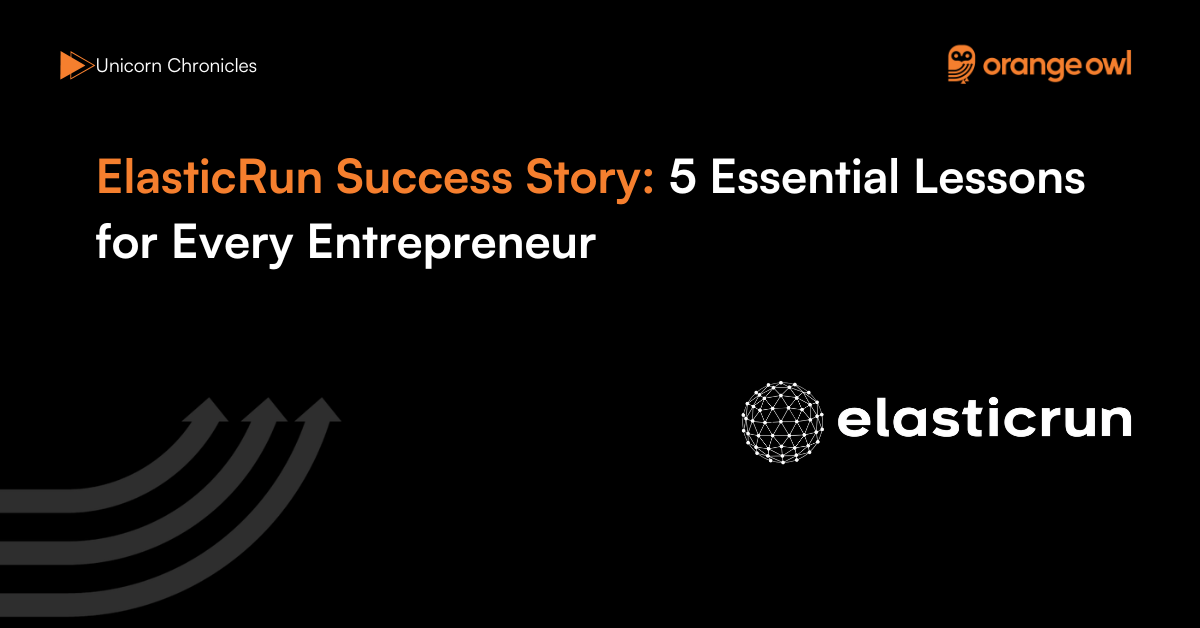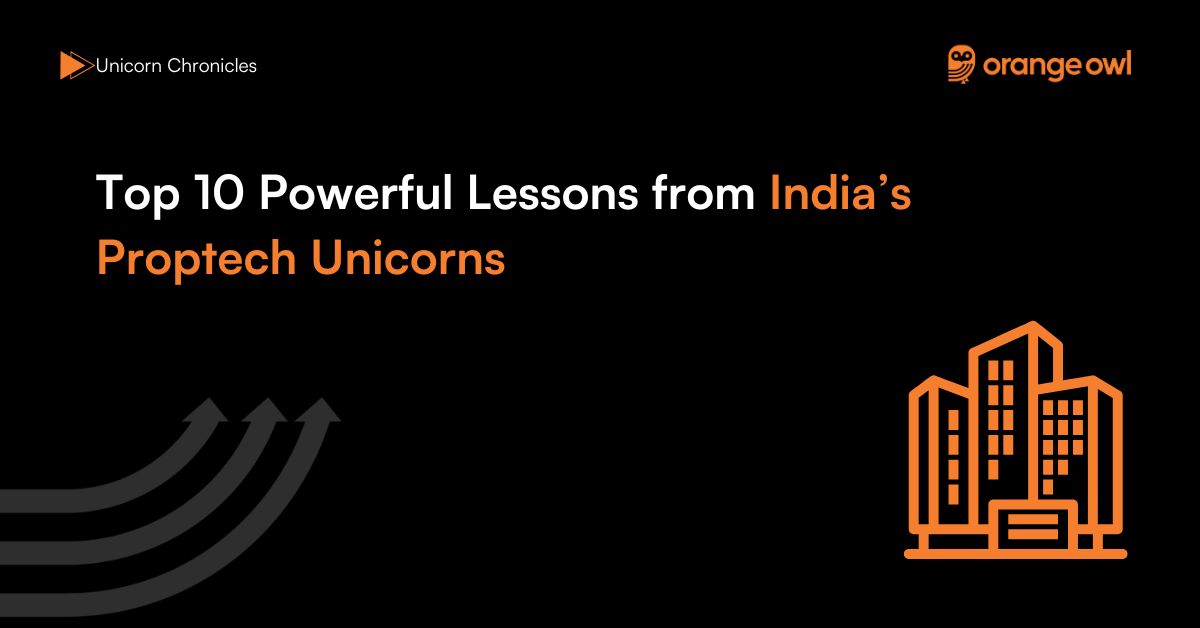ElasticRun Success Story: 5 Essential Lessons for Every Entrepreneur
Vivek Goel
June 17, 2025

Table of Contents
Introduction
ElasticRun is one of India’s most innovative and impactful B2B startups, redefining the way rural logistics and commerce operate. Founded in 2016, the company took on a challenge that many had either ignored or considered too complex to solve—connecting rural India’s fragmented retail landscape with formal supply chains. While the country’s consumption was rapidly growing in urban centers, rural markets remained underserved due to poor infrastructure, scattered demand, and limited visibility.
ElasticRun turned this gap into a massive opportunity by building a tech-enabled logistics and commerce platform. Unlike traditional logistics companies, ElasticRun operates on an asset-light model, using existing transportation infrastructure and idle capacity from local players—especially in Tier II, III, and IV towns. This not only kept costs low but also allowed unprecedented reach into India’s rural heartlands.
By acting as the extended arm of FMCG brands and allowing kirana stores to source products on-demand via its app, ElasticRun created a win-win for both sides of the supply chain. Today, the platform covers over 60% of India’s pin codes and serves more than 12 lakh kirana stores across the country.
“We always believed that there’s massive untapped potential in the rural consumption economy. Our goal was to create an invisible infrastructure that connects it all.” — Sandeep Deshmukh, Co-founder & CEO, ElasticRun
By leveraging an invisible logistics network, the startup scaled to service nearly 200,000 stores across 19,000 villages. ElasticRun isn’t just a logistics platform—it’s an infrastructure revolution designed to bring inclusivity, efficiency, and visibility to India’s vast but often-overlooked rural retail ecosystem.
Origin Story
The idea behind ElasticRun was born from the first-hand experiences of its three founders—Sandeep Deshmukh, Saurabh Nigam, and Shitiz Bansal—who had spent years in operations and logistics roles at companies like Amazon and Kirloskar. During their time managing supply chains, they recognized a critical gap: while India’s urban centers were well-served by large logistics networks, rural India remained largely disconnected. The existing infrastructure simply wasn’t designed for scale in the rural context.
Their collective insight led them to imagine a “virtual logistics network”—one that wouldn’t rely on owning physical assets like trucks or warehouses, but instead, intelligently leverage underutilized capacity across third-party assets. They envisioned a tech-first, data-driven backbone that could optimize routes, consolidate demand, and plug the rural supply chain into the national consumption grid.
“The best infrastructure is the one you don’t see. Our idea was to create something asset-light and demand-heavy—powered by intelligence, not ownership.”
— Sandeep Deshmukh, Co-founder & CEO, ElasticRun
This vision culminated in the official launch of ElasticRun in 2016. The platform was built to act as a plug-and-play logistics interface that could help FMCG companies penetrate rural markets while simultaneously helping kirana stores source inventory more efficiently. The model focused on extending the reach of brands and retailers, without building costly physical networks from scratch.
Business Landscape and Early Challenges
India’s logistics sector, valued at over $215 billion, is notoriously fragmented, especially outside urban areas. While large cities benefit from a robust ecosystem of third-party logistics players and warehousing services, rural India lacks structured supply chains.
For FMCG companies, this meant that up to 40% of potential rural demand went untapped due to distribution limitations. For small shop owners (kiranas), it translated into limited product access, inconsistent pricing, and a reliance on local distributors with limited assortments.
ElasticRun identified an opportunity to become the “rural reach engine” for these brands. But the path to execution was full of obstacles:
- Trust Gap: Many kirana store owners were wary of switching from familiar local distributors to a tech-driven platform. ElasticRun had to build credibility in communities that traditionally operated on relationships and face-to-face trust.
- Data Scarcity: There was no reliable demand data for rural India. ElasticRun had to build its own intelligence layer to predict stock requirements, delivery timelines, and consumption patterns based on behavioral and transactional data.
- Last-Mile Fragmentation: The rural last-mile was highly disorganized. Delivery networks were often informal, making it difficult to ensure timeliness and consistency at scale.
- Capital Efficiency: ElasticRun’s asset-light model, while scalable, was also risky in the early stages. The team had to prove that leveraging third-party logistics capacity could be just as reliable as owning and operating their own assets.
“We didn’t want to replace the existing supply chain—we wanted to enhance it. But building trust and consistency was the biggest challenge early on.”
— Sandeep Deshmukh
Despite these challenges, the founders remained committed to their approach, iterating on the model through pilot projects and phased rollouts. Their unique positioning—not as a disruptor, but as an enabler—allowed them to integrate more smoothly with FMCG brands’ existing workflows and gain adoption in rural markets.
Growth Strategies
ElasticRun’s rapid scale and eventual unicorn status didn’t come from traditional expansion tactics. Instead, the company pursued a focused, rural-first growth model grounded in technology, partnerships, and capital efficiency.
At the core of their approach was an asset-light infrastructure—rather than investing in trucks or warehouses, ElasticRun tapped into underutilized transportation capacity by aggregating existing third-party logistics players. This allowed the company to scale rapidly across geographies without heavy capital expenditure.
Their rural-focused B2B commerce model was a game-changer. ElasticRun empowered over 500,000 kirana stores across 500+ towns to source products directly via its mobile app. These stores could now bypass the traditional distributor model, gaining access to better pricing, a wider product selection, and the convenience of doorstep delivery. It wasn’t just about logistics—it was about democratizing access to goods in remote markets.
ElasticRun’s use of AI and demand forecasting further strengthened its value proposition. By analyzing transaction history, local events, and seasonality, their algorithms predicted demand at a hyper-local level. This allowed them to optimize delivery routes, reduce stockouts, and ensure timely fulfillment, even in remote regions where data had previously been scarce.
To fuel this ecosystem, ElasticRun forged deep partnerships with leading FMCG giants like Unilever, Nestlé, and ITC. These brands saw ElasticRun not as a vendor but as a strategic partner who could unlock rural India without the need for physical expansion. ElasticRun became their go-to rural distribution engine, helping them achieve presence in areas they previously couldn’t reach.
Finally, the company’s success was backed by a robust funding strategy. With over $430 million raised from marquee investors like SoftBank Vision Fund, Goldman Sachs, and Prosus, ElasticRun was well-capitalized to execute its vision. The funding not only enabled technology investments but also helped attract top talent and expand operations across states. As Sandeep Deshmukh put it,
“Before expansion, we proved the model in a few states. Once it worked, we scaled with precision—state by state, category by category.”
Marketing Strategies
Despite being a behind-the-scenes B2B player, ElasticRun invested in strategic marketing tactics tailored for India’s diverse rural landscape. Their marketing focus wasn’t on flashy campaigns but on building grassroots trust, enabling adoption, and positioning the brand as a dependable ally in rural commerce.
One of the first steps was launching ground activation programs. ElasticRun teams engaged directly with kirana store owners through local outreach events, vernacular content, and partnerships with regional representatives. These efforts helped establish a familiar, trustworthy presence in towns where word-of-mouth mattered more than online reviews.
More importantly, trust was built through performance. Kiranas began to trust ElasticRun after experiencing consistent, on-time deliveries, transparent pricing, and better margins. These operational successes became the company’s most effective marketing tool—each fulfilled promise reinforced credibility and encouraged organic referrals.
To make onboarding seamless, ElasticRun built a tech-driven app interface where retailers could join the network with just a few taps. The low-friction mobile experience removed the need for complex documentation or training, accelerating network growth across towns and districts.
Additionally, the company’s leadership invested in thought leadership as a subtle yet impactful marketing channel. By participating in industry forums and startup summits, the founders articulated a compelling vision of the “invisible internet” powering rural commerce. This helped ElasticRun gain recognition as a category creator rather than just another logistics company.
“Our marketing wasn’t just about selling. It was about educating retailers on the value of predictability, availability, and choice.”
— Sandeep Deshmukh
5 Essential Lessons Every Entrepreneur Should Learn from ElasticRun
1.Go Where the Market is Underserved
ElasticRun’s success began with a clear focus on rural India—an enormous market segment that was largely overlooked by mainstream logistics and commerce players. Instead of competing in saturated urban markets, the founders chose to address the unique challenges of rural distribution.
This untapped demand offered a vast growth opportunity, proving that sometimes the smartest move is to serve those who are underserved.
2.Leverage Existing Infrastructure
Rather than incurring massive capital expenditure to build a proprietary fleet or warehouses, ElasticRun adopted an asset-light model by aggregating underutilized transportation capacity.
This approach not only minimized upfront investment but also enabled rapid scalability. Entrepreneurs can learn that maximizing existing resources—rather than always building from scratch—can create faster, more efficient growth.
3.Build for Trust First, Growth Later
ElasticRun prioritized establishing credibility with rural kiranas over quick expansion. The early days focused on consistent delivery, transparent pricing, and relationship-building.
This patient, trust-first approach laid the foundation for long-term loyalty and sustainable growth. For startups, this is a reminder that scaling too fast without trust can backfire, especially in sensitive or fragmented markets.

4.Solve with Tech, Execute with Ground Truth
ElasticRun’s technology stack—including AI-powered demand forecasting and route optimization—was vital. However, the founders never lost sight of ground realities such as local supply inconsistencies, cultural nuances, and retailer behavior.
This blend of data-driven insights with on-the-ground understanding ensured solutions were practical and adaptable, not just theoretical.
5.Design for Adaptability
ElasticRun’s platform was built with flexibility at its core, enabling it to serve multiple product categories and expand geographically across diverse states.
The company avoided rigid models, continuously iterating to meet evolving market needs. Entrepreneurs should learn the importance of building scalable, adaptable systems that can pivot as markets change or new opportunities arise.
Conclusion: Key Takeaways from ElasticRun’s Journey
ElasticRun’s journey is a powerful example of smart disruption through thoughtful innovation. Rather than attempting to dismantle existing supply chains, ElasticRun enhanced and digitized them by combining technology, strategic partnerships, and ground-level execution. Their story demonstrates how India’s “Bharat” — the vast, rural hinterland — holds immense economic potential waiting to be unlocked through better access and trust.
By addressing rural supply chain inefficiencies and enabling global FMCG brands to reach far-flung kirana stores, ElasticRun has become an invisible yet indispensable player in India’s consumption story. As Sandeep Deshmukh insightfully puts it:
“India’s next billion consumers aren’t coming from big cities. They’re already spending—they just need access, reach, and trust.”
For entrepreneurs, ElasticRun’s success offers a critical lesson: you don’t always need to reinvent the wheel. Sometimes, connecting the existing wheels with better data, empathy, and operational rigor is all it takes to create a transformative business.


